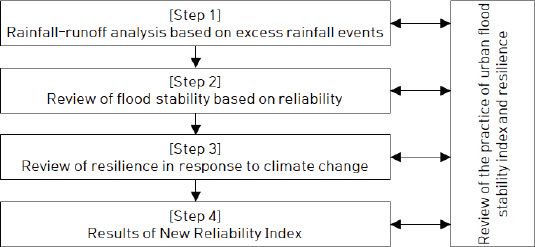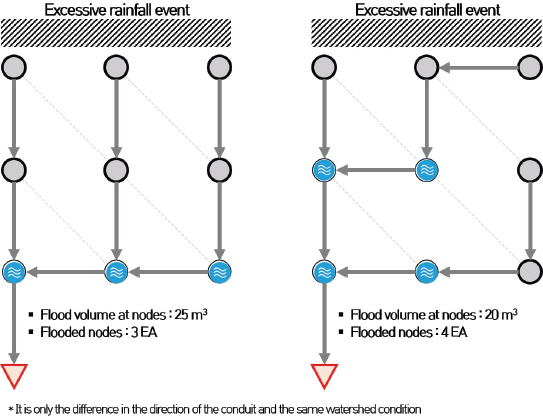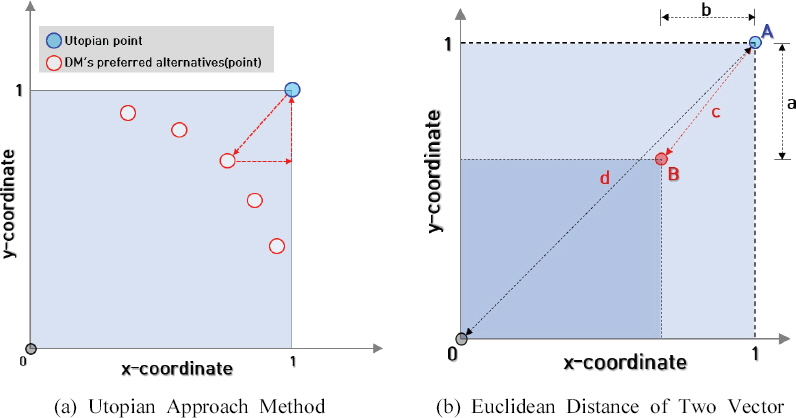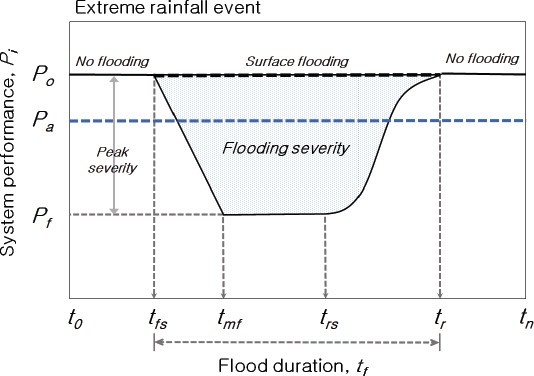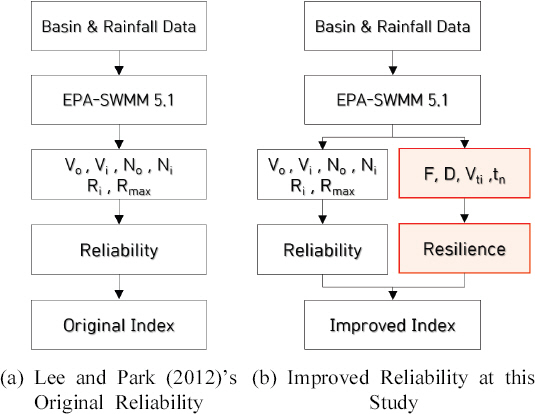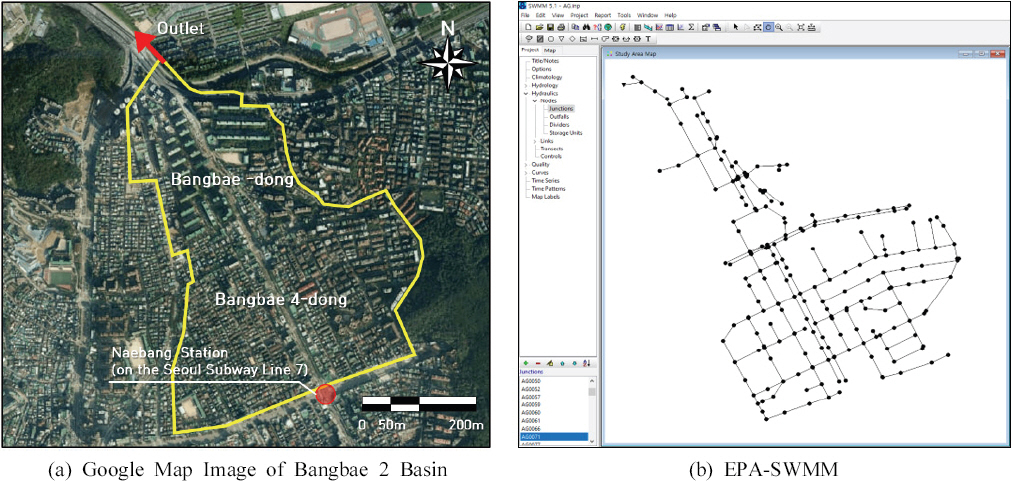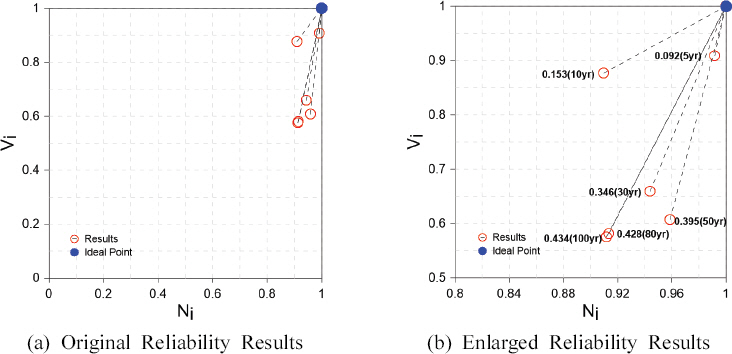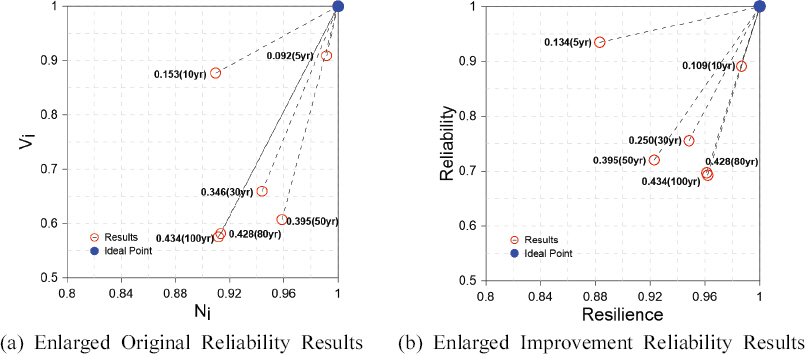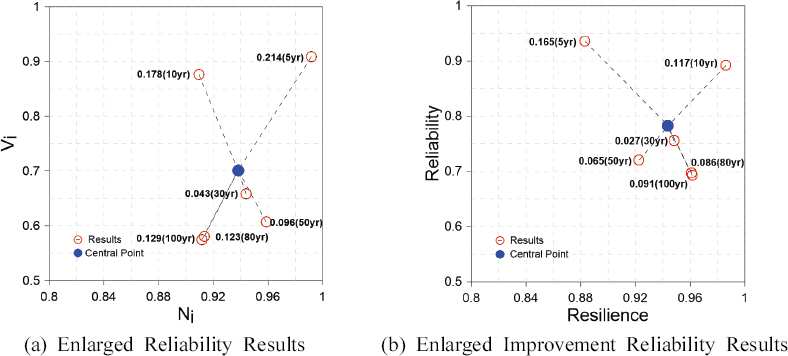 |
 |
- Search
| J. Korean Soc. Hazard Mitig. > Volume 20(5); 2020 > Article |
|
Abstract
In city centers, the damage caused by inundation is aggravated by rising populations and urbanization, which extend impermeable areas. Research is needed to identify the inundation risks caused by climate change and quantitatively assess the consequences. In this study, we proposed an improved reliability study which considers resilience in the original evaluation method for the reliability of a storm sewer network. Rainfall-runoff analysises were performed on a part of Bangbae 2 drainage basin in Seoul by applying Storm Water Management Model 5 Ver. Based on the results of the application of excessive rainfall events, the original reliability evaluation method was compared with the improved reliability evaluation method. Consequently, the effect of the improvement of the cluster about 30% was confirmed when selection the central value rather than the existing representative value. The improved reliability evaluation method proposed in this study can be used as a design objective function and as an index for evaluating the inundation risk in adjacent drainage basins.
žöĒžßÄ
ŽŹĄžčúŪôĒŽ°ú žĚłŪēú Ž∂ąŪą¨žąėŽ©īž†ĀžĚė ž¶ĚÍįÄžôÄ žĚłÍĶ¨žĚė Í≥ľŽįÄžßĎ ŽďĪžĚė Ž¨łž†úŽ°ú žĚłŪēėžó¨ ŽŹĄžč¨žßÄ Žāī žĻ®žąėŽįúžÉĚžóź ŽĒįŽ•ł ŪĒľŪēīÍįÄ ž¶ĚÍįÄŪēėÍ≥† žěąŽč§. ÍłįŪõĄŽ≥ÄŪôĒŽ°ú žĚłŪēú Ūôćžąė ŽįúžÉĚžĚė žúĄŪóėžĄĪžĚĄ ŪĆĆžēÖŪēėÍ≥† Í≤įÍ≥ľŽ•ľ ž†ēŽüČž†ĀžúľŽ°ú ŪŹČÍįÄŪēėÍłį žúĄŪēú žóįÍĶ¨ÍįÄ ŪēĄžöĒŪēėŽč§. Ž≥ł žóįÍĶ¨žóźžĄúŽäĒ Íłįž°īžóź ž†úžēąŽźú žöįžąėÍīÄŽßĚ žč†ŽĘįŽŹĄ žāįž†ēÍłįŽ≤ē žóįÍĶ¨žóź Ž≥ĶžõźŪÉĄŽ†•žĄĪžĚĄ Í≥†Ž†§Ūēú ÍįúžĄ†Žźú žč†ŽĘįŽŹĄ žóįÍĶ¨Ž•ľ ž†úžēąŪēėžėÄŽč§. Storm Water Management Model 5 Ver.žĚĄ ŽįĒŪÉēžúľŽ°ú žĄúžöłžčú Žį©Žįį2 ŽįįžąėŽ∂ĄÍĶ¨ žĚľŽ∂Ä žú†žó≠žóź ŽĆÄŪēī Íįēžöį-žú†ž∂úŽ∂ĄžĄĚžĚĄ žąėŪĖČŪēėžėÄŽč§. žīąÍ≥ľÍįēžöįžā¨žÉĀ ž†Āžö©žóź ŽĒįŽ•ł Í≤įÍ≥ľŽď§žĚĄ ŽįĒŪÉēžúľŽ°ú Íłįž°īžĚė žč†ŽĘįŽŹĄ žāįž†ēÍłįŽ≤ēÍ≥ľ ÍįúžĄ†Žźú žč†ŽĘįŽŹĄ žāįž†ēÍłįŽ≤ēžĚĄ žĚīžö©Ūēėžó¨ ŽĻĄÍĶźŪēėžėÄžúľŽ©į, Í∑ł Í≤įÍ≥ľ Íłįž°ī ŽĆÄŪĎúÍįí ŽĆÄŽĻĄ ž§Ďžč¨ Íįí žĄ†ž†ēžčú žēĹ 30%žĚė ÍįúžĄ†Žźú ÍĶįžßĎžĚė Ūö®Í≥ľŽ•ľ ŪôēžĚłŪēėžėÄŽč§. Ž≥ł žóįÍĶ¨žóźžĄú ž†úžēąŪēú ÍįúžĄ†Žźú žöįžąėÍīÄŽßĚ žč†ŽĘįŽŹĄ ŪŹČÍįÄÍłįŽ≤ēžĚÄ ŪĖ•ŪõĄ žĚłž†ĎŪēú ŽįįžąėŽ∂ĄÍĶ¨ÍįĄžĚė žúĄŪóėŽŹĄ ŪŹČÍįÄ ŽįŹ žĄ§Í≥ĄŽ™©ž†ĀŪē®žąėŽ°ú Ūôúžö©žĚī ÍįÄŽä•ŪēėŽč§.
ÍłįŪõĄŽ≥ÄŪôĒŽ°ú žĚłŪēī ŽįúžÉĚŪēėŽäĒ žěźžóįžě¨ŪēīžĚė žúĄŪóėžĚÄ ŽĻĄŽč® ÍĶ≠ŽāīŽŅźŽßĆ žēĄŽčąŽĚľ ž†Ą žßÄÍĶ¨ž†ĀžúľŽ°ú ž¶ĚÍįÄŪēėÍ≥† žěąŽč§. ŽŹĄžčúŪôĒ žĚīŪõĄ žßÄžÜ枆ĀžĚł žĚłÍĶ¨ ž¶ĚÍįÄžôÄ Í≥ľŽįÄžßĎ Í∑łŽ¶¨Í≥† žßÄžó≠ ÍįúŽįúŽ°ú žĚłŪēú žě¨žāį ÍįÄžĻėÍįÄ žÉĀžäĻŪēėŽ©īžĄú žěźžóįžě¨Ūēīžóź ŽĆÄŪēú ÍīĞ訞Ěī ŽÜížēĄžßÄÍ≥† žěąŽč§. žĶúÍ∑ľ ÍĶ≠ŽāīÍĪįž£ľ žĚłÍĶ¨žĚė ŽĆÄŽ∂ÄŽ∂ĄžĚÄ ŽŹĄžčúžßÄžó≠žóź žÉĚŪôúÍ∂ĆžĚī Ūéłž§ĎŽźėžĖī žěąžĖī žĻ®žąėžĚė ŽįúžÉĚŽĻąŽŹĄžôÄ Í∑łžóź ŽĒįŽ•ł ŪĒľŪēīžē° žó≠žčú ž¶ĚÍįÄŪēėŽäĒ ž∂ĒžĄłŽ°ú žĻ®žąėžúĄŪóėžóź ŽĆÄŪēú žě†žě¨Ž†•žĚĄ ŽāīŪŹ¨ŪēėÍ≥† žěąŽč§.
žĻėžąėžóź ÍīÄŪēú Ž¨łž†úŽäĒ Žß§ŽÖĄ ŽįėŽ≥Ķž†ĀžúľŽ°ú ŽįúžÉĚŪēėŽäĒ Ž¨łž†úŽ°ú ŪôćžąėžôÄ ÍįôžĚÄ žě¨Žāú žú†ŪėēžĚĄ ŽĆÄŽĻĄŪēėÍ≥†žěź ŽāīŽįįžąėžčúžĄ§žĚĄ ŽĻĄŽ°ĮŪēú Žį©žě¨žčúžĄ§Ž¨ľ Ūôúžö©Žį©žēą, Ūą¨žąėŽ©īž†Ā ŪôēŽĆÄžóź ŽĒįŽ•ł žöįžąėžú†ž∂ú ž†ÄÍįź Í∑łŽ¶¨Í≥† žßÄžó≠ž†Ā ŪäĻžĄĪžĚĄ Í≥†Ž†§Ūēú Ūôćžąė žúĄŪóėžĄĪ ŪŹČÍįÄžôÄ ÍīÄŽ†®Žźú Žč§žĖĎŪēú žóįÍĶ¨ÍįÄ žąėŪĖČŽźėžóąŽč§. ÍīÄŽ†® žóįÍĶ¨Žď§žĚĄ žāīŪéīŽ≥īŽ©ī Al-Amin et al. (2019)žĚÄ ŽŹôŽā®žēĄžčúžēĄžóź žúĄžĻėŪēú ÍįúŽįúŽŹĄžÉĀÍĶ≠Žď§žĚė žě¨Ūēī žúĄŪóėžĄĪžĚĄ Í≥†žįįŪēėÍ≥† ŪēīžąėŽ©ī žÉĀžäĻžóź ŽĒįŽ•ł Ūôćžąėž∑®žēĹžĄĪžóź ŽĆÄŪēú žóįÍĶ¨Ž•ľ žąėŪĖČŪēėžėÄŽč§. Sadiq et al. (2019)žĚÄ ŽĮłÍĶ≠žĚė žßÄžó≠žā¨ŪöĆÍłįŽįė Ūôćžąė žúĄŪóėžĄĪ ŪŹČÍįÄžôÄ ÍīÄŽ†®Žźú žóįÍĶ¨Žď§žĚĄ ž°įžā¨ŪēėÍ≥† Í≥ĶŪÜĶ žßÄŪĎúŽ•ľ Ūôúžö©Ūēú Žį©Ž≤ēŽ°†žĚė ŪēĄžöĒžĄĪžĚĄ ž£ľžě•ŪēėžėÄŽč§. Wu et al. (2020)žĚÄ ÍłįŪõĄ Ž≥ÄŪôĒŽ°ú žĚłŪēī ÍįēžöįžĚė ŽįúžÉĚŽĻąŽŹĄÍįÄ ž¶ĚÍįÄŪē† Í≤ɞ̥ Í≥†Ž†§Ūēėžó¨ Bayesian NetworkžĚĄ žĚīžö©Ūēėžó¨ Zhengzhou žú†žó≠žóź ŽĆÄŪēú ŪôćžąėžúĄŪóėŽŹĄ ŪŹČÍįÄŽ•ľ žč§žčúŪēėžėÄŽč§.
žě¨Žāúžú†Ūėēžóź žīąž†źžĚĄ ŽĎźŽäĒ žöįŽ¶¨ŽāėŽĚľžôÄ Žč¨Ž¶¨ ŽĮłÍĶ≠, žėĀÍĶ≠, Ūėłž£ľ ŽďĪžĚÄ ŽŹĄžčúŽāė žßÄžó≠žā¨ŪöĆžĚė žě¨Ūēī ž∑®žēĹžĄĪ ŪŹČÍįÄ ŽįŹ ž†ĀžĚĎ, ŪöĆŽ≥Ķ Žä•Ž†•žĚĄ ŪŹ¨Ūē®ŪēėŽäĒ Ž≥ĶžõźŽ†•(Resilience) ÍįúŽÖźžĚĄ Íįēž°įŪēėÍ≥† žěąŽč§(Kim et al., 2010). žĚīŽü¨Ūēú žĚīžú†Ž•ľ žāīŪéīŽ≥īŽ©ī žěźžóįžě¨ŽāúžúľŽ°ú ŽįúžÉĚŪēú ŪĒľŪēīžĚė Ž≥ĶÍĶ¨Ž•ľ žúĄŪēī žÜĆžöĒŽźėŽäĒ ŽĻĄžö©žĚī ž≤úŽ¨łŪēôž†ĀžúľŽ°ú ž¶ĚÍįÄŪēėÍ≥† žěąÍłį ŽēĆŽ¨łžĚīŽč§. ŽĒįŽĚľžĄú ŪôćžąėŽ•ľ ŪŹ¨Ūē®Ūēú žěźžóįžě¨ŪēīŽ•ľ ŽĆÄŽĻĄŪēėÍłį žúĄŪēú žóįÍĶ¨žôÄ ŽćĒŽ∂ąžĖī ŪĒľŪēī ŽįúžÉĚ žĚīŪõĄžóź žč†žÜćŪēú Ž≥ĶÍĶ¨Ž•ľ Ž≥īžě•Ūē† žąė žěąŽäĒ Ž≥ĶžõźŽ†•žóź ŽĆÄŪēú ÍįúŽÖźžĚĄ ŪÜĶŪēī žě¨ŪēīžúĄŪóėžĚĄ ÍįźžÜĆžčúŪā¨ žąė žěąŽäĒ ÍłįŽä•žĚĄ Ūē®ÍĽė ÍįēŪôĒŪēīžēľ ŪēúŽč§(Cutter et al., 2008; Campbell et al., 2019). ÍĶ≠ŽāīžóźžĄúŽŹĄ žěźžóįžě¨Žāú ÍīÄŽ¶¨žóź žěąžĖī Íłįž°īžĚė ŽĆÄžĚĎ‚čÖŽ≥ĶÍĶ¨ ž§Ďžč¨žĚė žā¨ŪõĄÍīÄŽ¶¨žóźžĄú Ž≤óžĖīŽāė žėąŽį©‚čÖŽĆÄŽĻĄ‚čÖŽĆÄžĚĎ‚čÖŽ≥ĶÍĶ¨žĚė ž†Ą ž£ľÍłįž†ĀžĚł ÍīÄŽ¶¨Ž•ľ ŪÜĶŪēú žā¨ŪöĆÍĶ¨ŪėĄžĚė ž§ĎžöĒžĄĪžĚī Íįēž°įŽźėÍ≥† žěąŽč§. Kwon et al. (2018)žĚÄ žöįžąėÍīÄŽßĚžĚė žĶúž†ĀžĄ§Í≥Ą Í≥ľž†ēžóź žĻ®žąėŪĒľŪēī žč¨ŽŹĄ(Failure Depth)Ž•ľ ŪÉĄŽ†•žĄĪ ž†úžēĹž°įÍĪīžúľŽ°ú Í≥†Ž†§Ūēėžó¨ žĻ®žąėŽüČÍ≥ľ žĄ§Í≥ĄŽĻĄžö©ÍįĄžĚė ÍīÄÍ≥ĄŽ•ľ Í≤ÄŪ܆ŪēėžėÄŽč§. Hong et al. (2019)žĚÄ Ž†ąžßąŽ¶¨žĖłžä§ žó≠ŽüČÍ≥ľ ž°įžßĀŪö®Í≥ľžĄĪ ÍįĄžĚė žėĀŪĖ•ÍīÄÍ≥Ą Ž∂ĄžĄĚžĚĄ ŪÜĶŪēī ž°įžßĀÍĶ¨žĄĪžõźŽď§žĚė žě¨Žāúžóź ŽĆÄŪēú žó≠ŽüČÍįēŪôĒ Žį©žēąžĚė ž§ĎžöĒžĄĪžĚĄ Íįēž°įŪēėžėÄŽč§. Seo et al. (2019)žĚÄ žě¨Žāú žėąŽį© Ž∂ĄžēľžĚė žēąž†ĄžĄúŽĻĄžä§ ÍĶ¨ž∂ēžĚĄ žúĄŪēú ÍĶ≠Žāīžôł žě¨Žāú žēąž†Ą ÍīÄŽ†® žóįÍĶ¨ÍįúŽįú ŽŹôŪĖ•žĚĄ ŪĆĆžēÖŪēėÍ≥† ž§Ďžě•Íłį ÍįúŽįúž†ĄŽěĶžóź ŽĆÄŪēú Žį©ŪĖ•žĄĪžĚĄ ž†úžēąŪēėžėÄŽč§. žĚīŽď§ žóįÍĶ¨Žď§žĚė Í≥ĶŪÜĶž†źžĚÄ ÍłįŪõĄŽ≥ÄŪôĒŽ•ľ Í≥†Ž†§Ūēú žě¨ŪēīžėąŽį© ŽįŹ žúĄŪóėŽŹĄ ŪŹČÍįÄŽ•ľ ŽįĒŪÉēžúľŽ°ú ŽĆÄžĚĎŽä•Ž†• ŪĖ•žÉĀžĚĄ žúĄŪēú žĚėžā¨Í≤įž†ēžĚė ž§ĎžöĒžĄĪžĚĄ žĖłÍłČŪēėÍ≥† žěąŽč§. žĚėžā¨Í≤įž†ēžĚė Í≥ľž†ēžóź žā¨ŪõĄ žąėžäĶ‚čÖŽ≥ĶÍĶ¨Í≥ľž†ēžĚė Žč®ž∂ēžĚĄ žúĄŪēú ŽĮłŽěė Ž≥ĶžõźŪÉĄŽ†•žĄĪžĚĄ Í≥†Ž†§ŪēėžėÄŽč§.
žĄ†ŪĖČ žóįÍĶ¨Žď§žóźžĄú Žč§Ž£®žóąŽćė žě¨ŪēīžúĄŪóėŽŹĄ ŪŹČÍįÄžôÄ ŽĮłŽěė Ž≥ĶžõźŪÉĄŽ†•žĄĪžĚė Í≥ĶŪÜĶžĄĪžĚÄ ŽįúžÉĚŪēėŽäĒ žó¨Žü¨ Ž¨łž†úŽď§žĚė ŽįúžÉĚ žú†Ūėē ŽįŹ žėĀŪĖ• Ž∂ĄžĄĚžĚĄ ŽįĒŪÉēžúľŽ°ú žú†Ūėē ŽįŹ žõźžĚłžóź ŽĆÄŪēėžó¨ žÉĀŽĆÄž†ĀžúľŽ°ú žúĄŪóėžóź ŽÖłž∂úŽźú ÍįížĚĄ žāįž∂úŪēėŽäĒ Í≥ľž†ēžĚīŽĚľÍ≥† ŪĆźŽč®ŽźúŽč§. žĚīžóź ŽĒįŽĚľ Ūôćžąė ŽįúžÉĚ ÍįÄŽä•žĄĪžĚĄ ŪĆĆžēÖŪēėÍ≥† ž†ēŽüČž†ĀžúľŽ°ú ŪŹČÍįÄŪēėŽäĒ ÍłįŽä•žóź ŽĆÄŪēú žóįÍĶ¨ÍįÄ ŪēĄžöĒŪēėŽč§. Ž≥ł žóįÍĶ¨žóźžĄúŽäĒ ÍįúžĄ†Žźú žč†ŽĘįŽŹĄ ÍłįŽ≤ēžĚĄ ŪÜĶŪēī žúĄŪóėŽŹĄ ŪŹČÍįÄž≤īÍ≥Ą ŽāīžóźžĄú ŪĆĆÍīīŪėĄžÉĀžóź ŽĆÄŪēú ž†ēŽüČž†ĀžĚł žßÄŪĎúŽ•ľ žĄ†ž†ēŪēėÍ≥†žěź ŪēėžėÄŽč§. žĄ†ŪĖČ žóįÍĶ¨Ž°úžć® Lee and Park (2012)žĚė Žč®žĚľ ŽįįžąėŽ∂ĄÍĶ¨žóźžĄú ÍīÄÍĪįžĚė ÍĶ¨ž°įž†Ā žĄ§Í≥Ą Ž≥ÄŪôĒžóź Žč§Ž•ł žĻėžąė žĄĪŽä•žóź Ž≥ÄŪôĒžóź ŽĆÄŪēú ŪŹČÍįÄ žßÄŪĎúžĚė žóįÍĶ¨ÍįÄ žěąŽč§. ŽėźŪēú, Song (2013)žĚė Žč§ž§Ď ŽįįžąėŽ∂ĄÍĶ¨žóźžĄúžĚė žÉĀŽĆÄž†ĀžĚł žĻėžąė žĄĪŽä• ŽĻĄÍĶźŽ•ľ žóįÍĶ¨ÍįÄ žěąŽč§. Ž≥ł žóįÍĶ¨žóźžĄúŽäĒ žē장ú ž†úžēąŪēú žóįÍĶ¨Žď§žĚė žöįžąėÍīÄŽßĚ žč†ŽĘįŽŹĄ ŪŹČÍįÄÍłįŽ≤ēžĚė žĄĪŽä•žĚĄ ÍłįŽįėžúľŽ°ú Ž≥ĶžõźŪÉĄŽ†•žĄĪ ÍįúŽÖźžĚĄ ž∂ĒÍįÄŽ°ú ž†Āžö©Ūēėžó¨ žÉĀŽĆÄž†ĀžúľŽ°ú ÍįúžĄ†Žźú žč†ŽĘįŽŹĄ ŪŹČÍįÄ ž†ĎÍ∑ľŽ≤ēžĚĄ ž†úžēąŪēėžėÄŽč§. Ž≥ł žóįÍĶ¨žĚė ž†ąžį®ŽäĒ Fig. 1Í≥ľ ÍįôŽč§.
Ž≥ł žóįÍĶ¨žĚė Ž™©ŪĎúŽäĒ Ž∂ąŪôēžč§Ūēú ÍłįŪõĄŽ≥ÄŪôĒŽ°ú žĚłŪēī ŽįúžÉĚŪēėŽäĒ žĻ®žąė Ž¨łž†úžôÄ ÍīÄŽ†®Ūēėžó¨ žöįžąėÍīÄŽßĚ žčúžä§ŪÖúžĚė ÍįúžĄ†Žźú žĻėžąėÍłįŽä•žĚė žąėžĻėŪôĒ Í≥ľž†ēžĚīŽč§. Ž≥ł žóįÍĶ¨žóźžĄúŽäĒ Íłįž°īžĚė žóįÍĶ¨žóźžĄúžĚė žĻėžąėÍłįŽä•žĚĄ ÍłįŽįėžúľŽ°ú žāįž†ēŽźú žč†ŽĘįŽŹĄžôÄ Ūē®ÍĽė ÍįúžĄ†Žźú žč†ŽĘįŽŹĄŽ°úžć® Íłįž°īžĚė žč†ŽĘįŽŹĄžóź Ž≥ĶžõźŪÉĄŽ†•žĄĪžĚĄ ŪÜĶŪē©Ūēú žóįÍĶ¨Ž•ľ žßĄŪĖČŪēėžėÄŽč§. žĚīžóź Ž≥ł žě•žóźžĄúŽäĒ žöįžąėÍīÄŽßĚ žč†ŽĘįŽŹĄ žāįž†ēŽį©Ž≤ēžóź ŪēĄžöĒŪēú ÍłįŽ≥ł žĚīŽ°†Í≥ľ Ž≥Ķžõź ŪÉĄŽ†•žĄĪžóź ŽĆÄŪēú ž†ēžĚėŽ•ľ žāīŪéīŽ≥īÍ≥†, Í≤įÍ≥ľ ŽŹĄž∂úÍ≥ľž†ēžóź ŽĆÄŪēú ž†ēŽ≥īŽ•ľ ŽāėžóīŪēėÍ≥†žěź ŪēúŽč§. žóįÍĶ¨Žį©Ž≤ēžóźŽäĒ ÍłįŪõĄŽ≥ÄŪôĒ žčúŽāėŽ¶¨žė§Ž•ľ ŽĆÄŽ≥ÄŪēėŽäĒ žīąÍ≥ľÍįēžöįžā¨žÉĀžĚĄ Í≥†Ž†§ŪēėžėÄžúľŽ©į žĻėžąė žĄĪŽä•Í≥ľ ÍīÄŽ†® žěąŽäĒ žßÄŪĎúžĚł žõĒŽ•ėŽįúžÉĚŽüČ(Flood Volume at Nodes, Vo)Í≥ľ žõĒŽ•ėŽįúžÉĚ žßÄž†ź žąė(Flooded Nodes, No) Í∑łŽ¶¨Í≥† žßÄžÜćÍįÄŽä•žĄĪžĚĄ ŽĆÄŽ≥ÄŪēėŽäĒ Ž≥ĶžõźŪÉĄŽ†•žĄĪ žßÄžąė(Resilience Index, Ri)Ž•ľ ŽįėžėĀŪēėžó¨ ŽŹĄžč¨žßÄ žĻėžąėŽĆÄžĪÖžóź ŽĆÄŪēú žįłÍ≥†žěźŽ£ĆŽ•ľ ŽŹĄž∂úŪēėŽäĒŽćį Í∑ł Ž™©ž†ĀžĚī žěąŽč§. Í≤įÍ≥ľŽŹĄž∂úžĚĄ žúĄŪēīžĄúŽäĒ ŽŹĄžč¨žßÄ žöįžąėÍīÄŽß̞̥ žĚīžö©Ūēú Íįēžöį-žú†ž∂úŪēīžĄĚžĚī ŪēĄžöĒŪēėŽ©į EPA Storm Water Management Model (SWMM) 5 Ver.žĚĄ Ūôúžö©ŪēėžėÄŽč§.
žöįžąėÍīÄŽßĚ žčúžä§ŪÖúžĚī ŽįúŪúėŪēīžēľ Ūē† žĄĪŽä•žĚÄ Í≤įÍĶ≠ žčúžä§ŪÖúžĚī žĄ§Í≥Ą Í≥ľž†ēžóź ŽįėžėĀŽźú ŽĻąŽŹĄŽ≥ĄŽ°ú žöĒÍĶ¨ŽźėŽäĒ žĻėžąė Žä•Ž†•žĚĄ ŽįúŪúėŪēėŽäĒ Í≤ÉžĚīŽč§. žě¶žĚÄ žßĎž§ĎŪėłžöįŽ°ú žĚłŪēú žĻėžąė žĄĪŽä•žĚė ž§ĎžöĒžĄĪžĚī ŽćĒžöĪ Íįēž°įŽź®žóź ŽĒįŽĚľ ÍīÄŽ†® Íłįžą† ÍįúŽįúžóźŽäĒ žčúÍįĄž†Ā‚čÖÍ≤Ĺž†úž†ĀžĚł žł°Ž©īžĚĄ ŽįėžėĀŪē®žúľŽ°úžć® žĚīŽ•ľ ŽĆÄžĚĎŪēėŽäĒ žöĒžÜĆÍłįžą†Ž°úžĚė žó≠Ūē†žĚī ŪēĄžöĒŪēėŽč§. žĚīžôÄ ÍīÄŽ†®Ūēėžó¨ Lee and Park (2012)Í≥ľ Song (2013)žĚÄ žöįžąėÍīÄŽßĚžĚė žĻėžąėžēąž†ĄžĄĪ ŪŹČÍįÄŽ•ľ žúĄŪēú žč†ŽĘįŽŹĄ Ž∂ĄžĄĚÍłįŽ≤ēžĚĄ ž†úžēąŪēėžėÄžúľŽ©į žĚīŽď§ žóįÍĶ¨žóźžĄúŽäĒ žõĒŽ•ėŽįúžÉĚŽüČÍ≥ľ žõĒŽ•ėŽįúžÉĚžßÄž†ź žąėŽ•ľ ŽįĒŪÉēžúľŽ°ú Fig. 2žôÄ ÍįôžĚī ÍīÄŽßĚ ÍĶ¨žĄĪžóź ŽĒįŽ•ł ŪĆĆÍīī ŪėĄžÉĀžĚĄ Í≥†Ž†§Ūēú žĻ®žąėžúĄŪóė ŪŹČÍįÄŽ•ľ žč§žčúŪēėžėÄŽč§.
Ž≥ł žóįÍĶ¨žóźžĄúžĚė ÍĪįŽ¶¨ž≤ôŽŹĄŽį©Ž≤ēžĚÄ ŪėĄžě¨ žöīžėĀ ž§ĎžĚł žöįžąėÍīÄŽßĚžčúžä§ŪÖúžóź žĻėžąėŽä•Ž†•žĚĄ ŪĆźŽč®ŪēėÍłį žúĄŪēú Žį©Ž≤ēžúľŽ°ú ŪėĄžě¨ Žä•Ž†• ŽĆÄŽĻĄ žīąÍ≥ľŪėłžöį žā¨žÉĀ ŽįúžÉĚžóź ŽĆÄŪēú žĄĪŽä•žĚė ŪĆĆÍīī ŪôēŽ•†žĚĄ Í≥†Ž†§ŪēėŽäĒ Í≤ÉžĚīŽč§. žĚī Í≥ľž†ēžóźžĄú Í≥†Ž†§Ūēú žßÄžąėŽď§žĚė Žč®žúĄžĚė žį®žõź ŽįŹ Ž≤ĒžúĄžĚė ž≤ôŽŹĄŽ•ľ ŽŹôžĚľžčúŪēėÍ≥† žÉĀŽĆÄž†ĀžĚł ŽĻĄÍĶźŽ•ľ ŪēėÍłį žúĄŪēī Utopian ApproachžĚė ÍĪįŽ¶¨ž≤ôŽŹĄŽį©Ž≤ēžĚĄ žĚīžö©ŪēėžėÄŽč§. ž¶Č žĚīžÉĀž†ź(Utopian Point)Í≥ľ ŪĆĆÍīīÍįÄ žĚľžĖīŽāėŽäĒ ŪėĄžě¨ žÉĀŪÉúžóź ŽĆÄŪēėžó¨ Í∑ł ÍĪįŽ¶¨ žį®žĚīŽ•ľ žĚīžö©ŪēėŽäĒ Žį©Ž≤ēžĚĄ žā¨žö©ŪēėžėÄŽč§. žĚīŽ•ľ Í∑łŽ¶ľÍ≥ľ žąėžčĚžúľŽ°ú ŪĎúŪėĄŪēėŽ©ī Fig. 3 ŽįŹ Eq. (1)Í≥ľ ÍįôŽč§.
ŪÉĄŽ†•žĄĪžĚė ÍįúŽÖźžĚÄ Í∑ľŽěė Žď§žĖī Žį©žě¨Ž∂ĄžēľžóźžĄú žě¨ŽāúŽ≥ĶžõźŽ†•žúľŽ°úžć® Ūôúžö©ŽźėŽäĒ ž£ľžöĒ žóįÍĶ¨ž£ľž†úžĚīŽč§. ŪÉĄŽ†•žĄĪžĚÄ ŪôėÍ≤Ĺž†ĀžĚīŽ©į žÉĚŪÉúž†ĀžĚł ž≤īÍ≥ĄžĚė Žä•Ž†•žĚĄ žĚėŽĮłŪēėŽ©į, žĚī Žä•Ž†•žĚÄ ÍĶźŽěÄžúľŽ°ú žĚłŪēú žėĀŪĖ•žĚĄ ŪĚ°žąėŪēėÍ≥†, ÍłįŽä•ž†ĀžúľŽ°ú žė®ž†ĄŪēú ŪėēŪÉúŽ°ú ŽźėŽŹĆžēĄÍįÄŽäĒ žě¨ž°įžßĀŪôĒÍįÄ žĚīŽ£®žĖīžßÄŽäĒ Í≥ľž†ēžĚĄ ŪŹ¨Ūē®ŪēúŽč§(Holling, 1973). Í≥ĶŪēôÍłįžą†ž†Ā ÍīÄž†źžóźžĄúžĚė Ž≥ĶžõźŪÉĄŽ†•žĄĪžĚÄ ŪĆĆÍīīÍįÄ žĚľžĖīŽāėÍłį ž†ĄžĚė ÍłįŽ≥ł žĄĪŽä•žúľŽ°úžĚė žě¨ÍłįŽä• ŪöĆŽ≥Ķ(Bounce-Back)žóź ž§Ďž†źžĚĄ ŽĎźžóąŽč§(Davoudi, 2012). Timmerman (1981)žĚÄ Žį©žě¨Ž∂ĄžēľžóźžĄú Ž≥ĶžõźŪÉĄŽ†•žĄĪžĚÄ žě¨Ūēī ŽįúžÉ̞̥ ŪĚ°žąėŪēėÍ≥† Ž≥ĶÍĶ¨Ūē† žąė žěąŽäĒ Žä•Ž†•žĚīŽĚľÍ≥† ž†ēžĚėŪēėžėÄŽč§. Butler et al. (2014)žĚÄ ŽŹĄžčú ÍłįŽįė žčúžä§ŪÖúžĚī žėąžôłž†ĀžĚł ž°įÍĪīžóź ŽĒįŽĚľ žĄ§Í≥Ą žąėŽ™Ö ŽŹôžēą žĄúŽĻĄžä§ žě•žē†žĚė ž†ēŽŹĄžôÄ ÍłįÍįĄžĚĄ žĶúžÜĆŪôĒŪēėŽäĒ ž†ēŽŹĄŽ•ľ Ž≥ĶžõźŽ†•žúľŽ°ú ž†ēžĚė ŪĖąŽč§. žĚīŽ•ľ ŽįĒŪÉēžúľŽ°ú Mugume et al. (2015)žĚÄ ŽŹĄžčúŽįįžąėžčúžä§ŪÖú(Urban Drainage Systems, UDSs)žĚė žě¨ŪēīŽįúžÉĚÍ≥ľ Ž≥ĶžõźŪÉĄŽ†•žĄĪÍįĄžĚė žÉĀÍīÄÍīÄÍ≥ĄŽ•ľ ž†ēŽüČŪôĒŪēėÍłį žúĄŪēú žóįÍĶ¨Ž•ľ Fig. 4žôÄ ÍįôžĚī ž†úžēąŪēėžėÄŽč§.
Fig. 4ŽäĒ žöįžąėÍīÄŽßĚ žčúžä§ŪÖúžĚė žĚīŽ°†ž†Ā žĻėžąėžĄĪŽä•Í≥ľ žīąÍ≥ľÍįēžöįžôÄ ÍįôžĚÄ žě¨ŪēīžôÄžĚė ÍīÄÍ≥ĄŽ•ľ ŪĎúŪėĄŪēú Í≥°žĄ†Pi (t)žĚīŽč§. P0ŽäĒ Ž≥łŽěė žöįžąėÍīÄŽßĚžĚė žĻėžąėžĄĪŽä• žąėž§ÄžĚĄ ŽāėŪÉÄŽāīŽ©į, PaŽäĒ ÍįÄžö© žĻėžąėžĄĪŽä• ŪēúÍ≥ĄžĻėŽ•ľ ŽāėŪÉÄŽāłŽč§. PfŽäĒ žĶúžÜĆ žĻėžąėžĄĪŽä• žÉĀŪÉúŽ•ľ ŽāėŪÉÄŽāłŽč§.
Í≥°žĄ†Pi (t)ŽäĒ žě¨Ūēī ŽįúžÉĚžúľŽ°ú žĚłŪēú žĄĪŽä• ž†ÄŪēėžóź žėĀŪĖ•žĚĄ ž£ľŽäĒ žč¨ÍįĀŽŹĄ(Severity)žôÄ Ž≥ĶÍĶ¨ ÍłįÍįĄtnžúľŽ°ú Í≤įž†ēŽźúŽč§(Hwang et al., 2015). žč¨ÍįĀŽŹĄŽäĒ žīĚ ŪôćžąėŽüČÍ≥ľ žīĚ žú†žěÖŽüČžúľŽ°ú Í≤įž†ēŽźúŽč§.t0ŽäĒ ÍįēžöįžĚė žīąÍłį ŽįúžÉĚŽč®Í≥ĄŽ°ú žõźŪôúŪēú žĻėžąėžĄĪŽä•žĚĄ ŽāėŪÉÄŽāīÍ≥† žěąŽč§. tfsŽäĒ žĻ®žąėŽįúžÉĚžúľŽ°úžĚłŪēú žčúžä§ŪÖúžĚė žĻėžąėžĄĪŽä• ÍįźžÜĆ žčúžěĎ žčúž†ź, tmfŽäĒ žčúžä§ŪÖúžĚė žĻėžąėžĄĪŽä•žĚī ÍįÄžě• ŽāģžĚÄ žÉĀŪÉúŽ•ľ ÍįÄŽ¶¨Ūā®Žč§.trsŽäĒ žĶúžÜĆŪēúžĚė ÍłįŽä•Žßƞ̥ žú†žßÄŪēėŽćė žčúžä§ŪÖúžĚī Ž≥ĶÍĶ¨ŽźėÍłį žčúžěĎŪē† ŽēĆžĚė žčúž†źžĚīŽ©į, tmfžĚÄ žčúžä§ŪÖúžĚė žĻėžąėžĄĪŽä•žĚī žõźÍłįŽä•žúľŽ°ú Ž≥ĶÍĶ¨ ŽźėžóąžĚĄ ŽēĆžĚė žčúž†źžĚīŽč§.tnžĚÄ žöįžąėÍīÄŽßĚ žĻėžąėžĄĪŽä•žĚī žõź žÉĀŪÉúŽ°ú ŽźėŽŹĆžēĄ žôĒžĚĄ ŽēĆÍĻĆžßÄžĚė žčúÍįĄžĚĄ Í≥†Ž†§ŪēúŽč§.
žĶúžĘÖž†ĀžúľŽ°ú Ž≥ĶžõźŪÉĄŽ†•žĄĪ RžĚÄ Hwang et al. (2015)žĚė ŽĮľÍįźŽŹĄžôÄ Mugume et al. (2015)žĚė žčĚžóź žĚėŪēī Eq. (2)Ž°ú ž†ēžĚėŽźúŽč§. žĻėžąė žĄĪŽä•žĚė ž≤ôŽŹĄžĚł Ž≥ĶžõźŪÉĄŽ†•žĄĪ žßÄžąėRžĚÄ žõź žĻėžąėžĄĪŽä• 1žóźžĄú žč¨ÍįĀŽŹĄŽ•ľ ÍįźŪēú ÍįížĚīŽč§. FŽäĒ žßÄž†źŽď§žóźžĄúžĚė ŪôćžąėŽüČžĚė žīĚŪē©žĚĄ žĚėŽĮłŪēėŽ©į,DŽäĒ ŪôćžąėŽįúžÉĚ žßÄž†źŽď§žĚė ŪôćžąėžßÄžÜćÍłįÍįĄžĚė ŪŹČÍ∑†ÍįížĚĄ žĚėŽĮłŪēúŽč§. VtiŽäĒ žöįžąėÍīÄŽßĚ ŽāīŽ∂ÄŽ°ú žú†žěÖŽźú žīĚ žú†žěÖŽüȞ̥ žĚėŽĮłŪēúŽč§. Ž≥ł žóįÍĶ¨žóźžĄúŽäĒtnžĚĄ žú†žó≠ ž∂úÍĶ¨žóźžĄúžĚė žú†ž∂úžĚī žĘÖŽ£ĆŽźú žčúÍįĄžĚĄ ŽįėžėĀŪēėžėÄŽč§. Ž≥ĶžõźŪÉĄŽ†•žĄĪRžĚė Ž≤ĒžúĄŽäĒ Eq. (3)Í≥ľ ÍįôŽč§.
Ž≥ł žóįÍĶ¨žĚė Ž™©ŪĎúŽäĒ Ž∂ąŪôēžč§Ūēú ÍłįŪõĄŽ≥ÄŪôĒŽ°ú žĚłŪēī ŽįúžÉĚŪēėŽäĒ žĻ®žąė Ž¨łž†úžôÄ ÍīÄŽ†®Ūēėžó¨ žöįžąėÍīÄŽßĚ žčúžä§ŪÖúžĚė ÍįúžĄ†Žźú žĻėžąėÍłįŽä•žĚė žąėžĻėŪôĒ Í≥ľž†ēžĚīŽč§. Ž≥ł žóįÍĶ¨žóźžĄúŽäĒ Íłįž°īžĚė žóįÍĶ¨žóźžĄúžĚė žĻėžąėÍłįŽä•žĚĄ ÍłįŽįėžúľŽ°ú žāįž†ēŽźú žč†ŽĘįŽŹĄžôÄ Ūē®ÍĽė ÍįúžĄ†Žźú žč†ŽĘįŽŹĄŽ°úžć® Íłįž°īžĚė žč†ŽĘįŽŹĄžóź Ž≥ĶžõźŪÉĄŽ†•žĄĪžĚĄ ŪÜĶŪē©Ūēú žóįÍĶ¨Ž•ľ žßĄŪĖČŪēėžėÄŽč§. EPA-SWMM 5.1žĚĄ žĚīžö©Ūēėžó¨ Í≤įž†ēŽźú Íįēžöį ŽĻąŽŹĄŽ≥Ą žīĚ ÍįēžöįŽüČ(Ri) ŽįŹ ž†Āžö©Žźú žĶúŽĆÄ ÍįēžöįŽüČ Íįí(Rmax)žĚĄ ŽŹĄž∂úŪēėžėÄŽč§. Íįēžöį ŽĻąŽŹĄŽ≥Ą žõĒŽ•ėŽįúžÉĚŽüČ(Vo)iÍ≥ľ ÍīÄŽßĚ Žāī žīĚ žú†žěÖŽüČ(Vt)ižĚĄ ŪÜĶŪēėžó¨ Eq. (4)žôÄ ÍįôžĚÄ ŽĻąŽŹĄŽ≥Ą žõĒŽ•ėŽįúžÉĚŽüČ ŽĻĄžú®(Vi)žĚĄ ŽŹĄž∂úŪēėžėÄŽč§. Íįēžöį ŽĻąŽŹĄŽ≥Ą žõĒŽ•ėŽįúžÉĚ žßÄž†ź Íįúžąė(No)ižôÄ žīĚ žßÄž†ź Íįúžąė(Nt)iŽ•ľ ŪÜĶŪēėžó¨ Eq. (5)žôÄ ÍįôžĚÄ ŽĻąŽŹĄŽ≥Ą žõĒŽ•ėŽįúžÉĚ žßÄž†ź ŽĻĄžú®NižĚĄ ŽŹĄž∂úŪēėžėÄŽč§. žĶúžĘÖž†ĀžúľŽ°ú ŽŹĄž∂úŽźú žõĒŽ•ėŽįúžÉĚŽüČ ŽĻĄžú®(Vi)Í≥ľ žõĒŽ•ėŽįúžÉĚ žßÄž†ź ŽĻĄžú®(Ni)žĚĄ Ūē®ÍĽė Í≥†Ž†§Ūēú žč†ŽĘįŽŹĄ Í≤įÍ≥ľÍįížĚÄ Eq. (6)Í≥ľ ÍįôŽč§.
Ž®ľž†Ä žč†ŽĘįŽŹĄ Í≤įÍ≥ľÍįíÍ≥ľ Ž≥ĶžõźŪÉĄŽ†•žĄĪ ÍįížĚĄ žāįž†ēŪēėžėÄŽč§. žč†ŽĘįŽŹĄžôÄ Ž≥ĶžõźŪÉĄŽ†•žĄĪžĚĄ ž†ĎŽ™©žčúŪā® ÍįúžĄ†Žźú žč†ŽĘįŽŹĄ ÍįížĚĄ žāįž†ēŪēėžėÄŽč§. Í∑ł ŪõĄ, žē장ú žāįž†ēŪēú Íłįž°īžĚė žč†ŽĘįŽŹĄ Í≤įÍ≥ľžôÄ Ž≥ł žóįÍĶ¨žóźžĄúžĚė ÍįúžĄ†Žį©žēąžĚł Ž≥ĶžõźŪÉĄŽ†•žĄĪ ÍįížĚĄ ŽįėžėĀŪēú ÍįúžĄ†Žźú žč†ŽĘįŽŹĄ Í≤įÍ≥ľŽ•ľ ÍĪįŽ¶¨ž≤ôŽŹĄŽį©Ž≤ēžĚĄ žā¨žö©Ūēėžó¨ ŽĻĄÍĶźŪēėžėÄŽč§. Íłįž°īžĚė žöįžąėÍīÄŽßĚ žč†ŽĘįŽŹĄžĚė žóįÍĶ¨žĚė Í≤Ĺžöį Fig. 5žĚė (a)žôÄ ÍįôžĚī ÍĪįŽ¶¨ž≤ôŽŹĄŽį©Ž≤ēžĚĄ žā¨žö©ŪēėÍłį žúĄŪēėžó¨ žĘĆŪĎúŪŹČŽ©īžóźžĄú ÍįĀ ž∂ēžóź Žß§ÍįúŽ≥ÄžąėžĚł žīąÍ≥ľÍįēžöįžóź ŽĆÄŪēú žõĒŽ•ėŽįúžÉĚ žßÄž†ź žąėžôÄ žõĒŽ•ėŽüȞ̥ ž†Āžö©ŪēėžėÄŽč§. Ž≥ł žóįÍĶ¨žóźžĄúŽäĒ Fig. 5žĚė (b)žôÄ ÍįôžĚī ŽŹĄž∂úŽźú žč†ŽĘįŽŹĄ Í≤įÍ≥ľÍįíÍ≥ľ Ž≥ĶžõźŪÉĄŽ†•žĄĪ Í≤įÍ≥ľÍįížĚĄ Žß§ÍįúŽ≥ÄžąėŽ°ú Ž≥ÄÍ≤ĹŪēėžó¨ ÍįĀÍįĀžĚė ŽĎź žßÄžąėŽ•ľ ŪēėŽāėžĚė žßÄžąėŽ°ú ŪÜĶŪē©ŪēėžėÄŽč§. Í≤įÍ≥ľ ŽŹĄž∂úžĚė ž†ąžį®ŽäĒ Žč§žĚĆžĚė Fig. 5žôÄ ÍįôŽč§.
žóįÍĶ¨ ŽĆÄžÉĀ žú†žó≠žĚÄ ÍįēŽā®ÍĶ¨ Žį©ŽįįŽ≥łŽŹô ŽįŹ Žį©Žįį4ŽŹô žĚľŽĆÄžĚė žēĹ 85.3 hažĚė žú†žó≠žĚīŽ©į, žú†žó≠žóźžĄú ŽįúžÉĚŪēú žú†ž∂úŽüČžĚÄ ŽŹôžěĎŽĆÄÍĶź žĚłÍ∑ľžĚė ŽįėŪŹ¨ž≤úžúľŽ°ú žú†ž∂úŽźúŽč§(Fig. 6). žīĚ 215ÍįúžĚė Žß®ŪôÄÍ≥ľ 228ÍįúžĚė ÍīÄÍĪįŽ°ú žĚīŽ£®žĖīž†ł žěąžúľŽ©į žú†žó≠Ž©īž†ĀžĚė ŽĆÄŽ∂ÄŽ∂ĄžĚī žēĄŪĆĆŪäł, ŽĻĆŽĚľžôÄ ÍįôžĚÄ ž£ľÍĪįžčúžĄ§Ž°ú ÍĶ¨žĄĪŽźėžĖīžěąŽč§. žěźžĄłŪēú žú†žó≠žĚė ž†ēŽ≥īŽ•ľ Table 1žóź ŽāėžóīŪēėžėÄŽč§. ŪäĻŪěą ŪēīŽčĻ žú†žó≠žĚė Í≤Ĺžöį 2001ŽÖĄ 7žõĒ, 2010ŽÖĄ 9žõĒ ŽįŹ 2011ŽÖĄ 7žõĒ žĄúžöłžóźžĄú ŽįúžÉĚŪēú ŽĆÄÍ∑úŽ™® žĻ®žąėŪĒľŪēīžĚė žßĎž§Ďž†ĀžĚł ŽįúžÉĚžßÄžó≠žúľŽ°ú žĶúÍ∑ľÍĻĆžßÄ žĻ®žąėžėąŽį© ŽĆÄŪėē žöįžąėÍīÄŽ°ú ž¶ĚžĄ§žā¨žóÖžĚī žč§žčúŽźú žú†žó≠žóź ŪēīŽčĻŪēúŽč§. ŪėĄžě¨ ÍĶ≠ÍįÄ žąėžěźžõźÍīÄŽ¶¨ žĘÖŪē©ž†ēŽ≥ī žčúžä§ŪÖú(WAMIS)žóźžĄú žě¨ŪēīžúĄŪóėžßÄÍĶ¨ žĻ®žąėžúĄŪóė 1ŽďĪͳȞúľŽ°ú Ž∂ĄŽ•ėŽźėžĖīžěąŽč§. Ž∂ĄžĄĚžĚĄ žúĄŪēī ž†Āžö©Žźú Íįēžöįžā¨žÉĀžĚÄ žĄúžöłžĚė ŪôēŽ•†ÍįēžöįŽüȞ̥ ŽįĒŪÉēžúľŽ°ú Yoo and Na (2019)žĚė žóįÍĶ¨žóź ŽĒįŽĚľ žĄúžöłžĚė ž†Āž†ē Ūėłžöįžā¨žÉĀžĚł ž§ĎŪėłžöįžóźžĄú žĶúŽĻąŽ∂ĄžúĄžĚł 2Ž∂ĄžúĄŽ≤ē(Huff‚Äôs Quartile Method)žĚĄ ž†Āžö©ŪēėžėÄŽč§(Table 2).
Ž≥ł žě•žóźžĄúŽäĒ Ž≥ĶžõźŪÉĄŽ†•žĄĪžĚĄ Í≥†Ž†§Ūēú ÍįúžĄ†Žźú žöįžąėÍīÄŽßĚ žč†ŽĘįŽŹĄ žāįž†ēÍ≤įÍ≥ľŽ•ľ ŽāėžóīŪēėžėÄŽč§. ÍįúžĄ†Žźú žč†ŽĘįŽŹĄ žāįž†ēÍ≤įÍ≥ľžôÄžĚė ŽĻĄÍĶźŽ•ľ žúĄŪēī Íłįž°īžĚė žč†ŽĘįŽŹĄ ŪŹČÍįÄŽį©Ž≤ēžúľŽ°ú ŽŹĄž∂úŽźú Í≤įÍ≥ľŽ•ľ Í∑łŽ¶ľÍ≥ľ Ūē®ÍĽė ž†úžčúŪēėžėÄŽč§. Íłįž°īžĚė žöįžąėÍīÄŽßĚ žč†ŽĘįŽŹĄ ž†ēŽüČŪôĒ žčĚžóź ŽĒįŽ•ł žč§žú†žó≠ ž†Āžö© Í≤įÍ≥ľÍįížĚÄ Table 3Í≥ľ ÍįôŽč§.
Comparison of Reliability Results for Frequency (Duration 1-hr)
Table 3žĚÄ Žį©Žįį 2 ŽįįžąėŽ∂ĄÍĶ¨žóźžĄúžĚė 1žčúÍįĄ ŪôēŽ•†ÍįēžöįžĚė ŽĻąŽŹĄŽ≥Ą žč†ŽĘįŽŹĄ Í≤įÍ≥ľÍįížĚīŽč§. Íįēžöį ŽĻąŽŹĄ ž¶ĚÍįÄŽ°ú žĚłŪēú ÍįēžöįŽüČ ž¶ĚÍįÄŽ°ú žīĚ ŪôćžąėŽüČÍ≥ľ ÍīÄŽßĚžúľŽ°úžĚė žīĚ žú†žěÖŽüČžĚė ž¶ĚÍįÄŽ•ľ ŪôēžĚłŪēėžėÄŽč§. Íįēžöį ŽįúžÉĚ ŽĻąŽŹĄÍįÄ ž¶ĚÍįÄŪē®žóź ŽĒįŽĚľ žõĒŽ•ėŽįúžÉĚŽüČžĚÄ ž¶ĚÍįÄŪēėŽäĒ žĖĎžÉĀžĚĄ Ž≥īžėÄžßÄŽßĆ, žõĒŽ•ėŽįúžÉĚ žßÄž†ź žąėŽäĒ žĄ†Ūėēž†ĀžĚł ž¶ĚÍįÄ žĖĎžÉĀžĚĄ Ž≥īžĚīžßÄ žēäžēėŽč§. Í∑ł Í≤įÍ≥ľ, 5ŽÖĄ ŽĻąŽŹĄ ÍįēžöįžóźžĄúžĚė žč†ŽĘįŽŹĄ Í≤įÍ≥ľÍįížĚÄ 0.935žĚīžßÄŽßĆ, 100ŽÖĄ ŽĻąŽŹĄ ÍįēžöįžóźžĄúžĚė žč†ŽĘįŽŹĄ Í≤įÍ≥ľÍįížĚÄ 0.693Ž°ú žēĹ 26% ÍįźžÜĆŪēėžėÄŽč§. ÍįēžöįŽüČ ž¶ĚÍįÄžóź ŽĒįŽĚľ žöįžąėÍīÄŽßĚžĚė žĻėžąėžĄĪŽä•žĚÄ Íįēžöį ŽĻąŽŹĄžôÄ ŽįėŽĻĄŽ°ÄŪēėžó¨ ÍįźžÜĆŪēėŽäĒ žĖĎžÉĀžĚĄ Ž≥īžėÄŽč§.
Figs. 7žĚė (a), (b)ŽäĒ Íłįž°īžóź ž†úžēąŽźú žöįžąėÍīÄŽßĚ žč†ŽĘįŽŹĄ ŪŹČÍįÄÍłįŽ≤ēžúľŽ°ú žāįž†ēŽźú žč†ŽĘįŽŹĄ Í≤įÍ≥ľÍįížĚĄ Utopian ApproachŽį©Ž≤ēžúľŽ°ú ŽāėŪÉÄŽāł Í∑łŽěėŪĒĄžĚīŽč§. ÍįēžöįŽįúžÉĚ ŽĻąŽŹĄžĚė ž¶ĚÍįÄžóź ŽĒįŽĚľ žč†ŽĘįŽŹĄ Í≤įÍ≥ľÍįíŽď§Í≥ľ žĚīžÉĀž†ź(1,1) Í≥ľžĚė ÍĪįŽ¶¨ÍįÄ žĶúžÜĆ 0.092žóźžĄú žĶúŽĆÄ 0.434ÍĻĆžßÄžĚė ÍįížĚĄ ÍįĖŽäĒ Í≤ÉžúľŽ°ú ŽāėŪÉÄŽā¨Žč§. ÍįúžĄ†Žźú žč†ŽĘįŽŹĄ Í≤įÍ≥ľÍįí ŽŹĄž∂úžĚĄ žúĄŪēú Ž≥ĶžõźŪÉĄŽ†•žĄĪ Í≤įÍ≥ľŽäĒ Table 4žôÄ ÍįôŽč§.
Comparison of Resilience Results for Frequency (Duration 1-hr)
Table 4ŽäĒ 1žčúÍįĄ ŪôēŽ•†ÍįēžöįžĚė Íįēžöį ŽĻąŽŹĄŽ≥Ą Ž≥ĶžõźŪÉĄŽ†•žĄĪ Í≤įÍ≥ľÍįížĚīŽč§. ŽĻąŽŹĄžóź ŽįėŽĻĄŽ°ÄŪēėŽäĒ žĖĎžÉĀžĚĄ ŽĚą žē장† žč†ŽĘįŽŹĄ Í≤įÍ≥ľÍįíÍ≥ľ Žč¨Ž¶¨ Ž≥ĶžõźŪÉĄŽ†•žĄĪžĚÄ 5ŽÖĄ ÍįēžöįŽĻąŽŹĄžóźžĄúžĚė Žč§Ž•ł ŽĻąŽŹĄŽď§žĚė Í≤įÍ≥ľÍįížóź ŽĻĄŪēī ŪŹČÍ∑† Ūôćžąė ÍłįÍįĄžĚī žÉĀŽĆÄž†ĀžúľŽ°ú ŽÜíÍ≤Ć ŽāėŪÉÄŽā¨Žč§. Íįēžöį ŽįúžÉĚŽĻąŽŹĄžĚė ž¶ĚÍįÄŽ°ú žĚłŪēī ž†Ąž≤īž†ĀžĚł žú†žěÖŽüČžĚī ž¶ĚÍįÄŪēėžó¨ ŪôćžąėŽüČžĚī ž¶ĚÍįÄŪēėŽćĒŽĚľŽŹĄ, Ūēú ÍįúžĚė žßÄž†źžóź ŪôćžąėŽüČžĚī žßĎž§ĎŽźúŽč§Ž©ī, Ž≥ĶžõźŪÉĄŽ†•žĄĪžĚÄ ÍįźžÜĆŪēúŽč§ŽäĒ Í≤ɞ̥ žĚėŽĮłŪēúŽč§.
Figs. 8žĚė (a), (b)ŽäĒ Ž≥ĶžõźŪÉĄŽ†•žĄĪ Í≤įÍ≥ľŽ•ľ Utopian ApproachŽį©Ž≤ēžúľŽ°ú ŽāėŪÉÄŽāł Í∑łŽěėŪĒĄžĚīŽč§. Ž≥ĶžõźŪÉĄŽ†•žĄĪ Í≤įÍ≥ľÍįíŽď§Í≥ľ žĚīžÉĀž†ź(1,1)Í≥ľžĚė ÍĪįŽ¶¨ÍįÄ žĶúžÜĆ 0.109žóźžĄú žĶúŽĆÄ 0.434žĚė ÍįížĚĄ ÍįĖŽäĒ
Í≤ÉžúľŽ°ú ŽāėŪÉÄŽā¨Žč§. ÍįēžöįŽĻąŽŹĄÍįÄ ž¶ĚÍįÄŪē®žóź ŽĒįŽĚľ ŽĻąŽŹĄŽ≥Ą Í≤įÍ≥ľÍįíÍ≥ľ žĚīžÉĀž†źÍ≥ľžĚė ÍĪįŽ¶¨ÍįÄ ž¶ĚÍįÄŪēėŽäĒ žĄ†Ūėēž†ĀžĚł žĖĎžÉĀžĚĄ Ž≥īžĚīŽäĒ žč†ŽĘįŽŹĄ Í≤įÍ≥ľžôÄ Žč¨Ž¶¨, Ž≥ĶžõźŪÉĄŽ†•žĄĪžĚė Í≤įÍ≥ľŽäĒ ŽĻąŽŹĄžôÄ ÍīÄÍ≥ĄžóÜŽäĒ ŽĻĄžĄ†Ūėēž†ĀžĚł žĖĎžÉĀžĚī ŽāėŪÉÄŽā¨Žč§.
Figs. 9žĚė (a), (b)ŽäĒ Íłįž°īžĚė ž†ēŽüČŪôĒ Žźú žč†ŽĘįŽŹĄ ÍįíÍ≥ľ Ž≥ĶžõźŪÉĄŽ†•žĄĪžĚĄ ŽįėžėĀŪēú ÍįúžĄ†Žźú žč†ŽĘįŽŹĄ ÍįížĚė Utopian Approach ŽĻĄÍĶź Í∑łŽěėŪĒĄžĚīŽč§. Fig. 9(a)žôÄ ÍįôžĚī Íłįž°īžĚė žöįžąėÍīÄŽßĚ žč†ŽĘįŽŹĄ žāįž†ēÍłįŽ≤ēžóź ŽĒįŽ•īŽ©īxž∂ēÍ≥ľyž∂ēžóź ÍįĀÍįĀ žõĒŽ•ėŽįúžÉĚ žßÄž†ź žąė(Ni)žôÄ žõĒŽ•ėŽįúžÉĚŽüČ(Vi)žĚĄ ž†Āžö©ŪēėžėÄŽč§. Í∑łŽü¨Žāė (b)žĚė Ž≥ł žóįÍĶ¨žóźžĄúŽäĒxž∂ēžóźŽäĒ Ž≥ĶžõźŪÉĄŽ†•žĄĪ(Resilience)žĚĄ ž†Āžö©ŪēėÍ≥†,yž∂ēžóź Íłįž°īžĚė žč†ŽĘįŽŹĄ(Reliability)Ž•ľ ž†Āžö©ŪēėžėÄŽč§. Íłįž°īžĚė ž†ēŽüČŪôĒŽźú žč†ŽĘįŽŹĄ Í≤įÍ≥ľÍįížóźžĄúžĚė žĚīžÉĀ ÍįíÍ≥ľ ŽĻąŽŹĄŽ≥Ą Í≤įÍ≥ľÍįíŽď§žĚė žā¨žĚī ÍĪįŽ¶¨ ÍįíŽď§žĚė žīĚ Ūē©žĚÄ 1.848žĚīžóąžúľŽ©į, ÍįúžĄ†Žźú žč†ŽĘįŽŹĄ Í≤įÍ≥ľÍįížóźžĄúžĚė žĚīžÉĀ ÍįíÍ≥ľ ŽĻąŽŹĄŽ≥Ą Í≤įÍ≥ľÍįíŽď§žĚė žā¨žĚī ÍĪįŽ¶¨ ÍįíŽď§žĚė žīĚ Ūē©žĚÄ 1.75žėÄŽč§. Íłįž°īžĚė žč†ŽĘįŽŹĄžóź Ž≥ĶžõźŪÉĄŽ†•žĄĪ ÍįúŽÖźžĚĄ ŽŹĄžěÖŪē®žúľŽ°úžć®, žĚīžÉĀ ÍįíÍ≥ľ ŽĻąŽŹĄŽ≥Ą Í≤įÍ≥ľÍįíŽď§žĚė ÍĪįŽ¶¨žĚė Ūē©žĚī ÍįĀÍįĀ 1.848žóźžĄú 1.75Ž°ú 5%ÍįÄ ÍįźžÜĆŪēėžó¨ žĚīžÉĀž†ź(1,1)žóź ŽćĒžöĪ ÍįÄÍĻĆžõĆ ž°ĆŽč§. žĚīŽäĒ žĚīžÉĀž†źÍ≥ľžĚė ÍĪįŽ¶¨Ž•ľ ŽĻĄÍĶźŪēėžó¨ ÍįÄžě• ÍĪįŽ¶¨ÍįÄ žßßžĚÄ ŽĆÄžēąžĚĄ Ūē©žĚėžēąžúľŽ°ú žĪĄŪÉĚŪēėŽäĒ Žį©Ž≤ēžĚł Utopian Approachžóź ŽĒįŽĚľ, ÍįúžĄ†Žźú žč†ŽĘįŽŹĄÍįÄ Íłįž°īžĚė žč†ŽĘįŽŹĄŽ≥īŽč§ ŽćĒžöĪ žĚīžÉĀž†ĀžĚł žßÄžąėžĚīŽč§.
Figs. 10žĚė (a), (b)ŽäĒ Íłįž°īžóź ž†úžēąŽźú žöįžąėÍīÄŽßĚ žč†ŽĘįŽŹĄ ŪŹČÍįÄÍłįŽ≤ēžúľŽ°ú ŽŹĄž∂úŽźú žč†ŽĘįŽŹĄ Í≤įÍ≥ľÍįí Fig. 10(a)žôÄ Ž≥ĶžõźŪÉĄŽ†•žĄĪ žßÄžąėŽ•ľ ŽįėžėĀŪēú ÍįúžĄ†Žźú žč†ŽĘįŽŹĄ Í≤įÍ≥ľÍįí Fig. 10(b)Ž•ľ ŽĻĄÍĶźŪēėŽäĒ Median Approach ŽĻĄÍĶź Í∑łŽěėŪĒĄžĚīŽč§. Íłįž°īžĚė ÍłįŽ≤ēžúľŽ°ú ŽŹĄž∂úŽźú žč†ŽĘįŽŹĄ Í≤įÍ≥ľÍįí Fig. 10(a)žóźžĄúžĚė ž§Ďžč¨ ÍįíÍ≥ľ Í≤įÍ≥ľÍįíŽď§žĚė žā¨žĚī ÍĪįŽ¶¨ ÍįíŽď§žĚė Ūē©žĚÄ 0.782žĚīžóąžúľŽ©į, ÍįúžĄ†Žźú žč†ŽĘįŽŹĄ ÍłįŽ≤ēžúľŽ°ú ŽŹĄž∂úŽźú Í≤įÍ≥ľÍįí Fig. 10(b)žóźžĄúžĚė ž§Ďžč¨ ÍįíÍ≥ľ Í≤įÍ≥ľÍįíŽď§žĚė žā¨žĚī ÍĪįŽ¶¨ ÍįíŽď§žĚė Ūē©žĚÄ 0.551žĚīžóąŽč§. žÉĀŽč®žĚė ŽĎź Í∑łŽěėŪĒĄžôÄ ÍįôžĚī Íłįž°īžĚė žč†ŽĘįŽŹĄžóź Ž≥ĶžõźŪÉĄŽ†•žĄĪžĚĄ ŽįėžėĀŪē®žúľŽ°úžć®, Íłįž°īžĚė ŪėēŪÉúžóźžĄú žēĹ 30%ŽßĆŪĀľ ž§Ďžč¨ ÍįíÍ≥ľ Í≤įÍ≥ľÍįíŽď§ žā¨žĚī ÍĪįŽ¶¨ÍįÄ ÍįźžÜĆŪēėžėÄžúľŽĮÄŽ°ú, žÉĀŽĆÄž†ĀžúľŽ°ú ŽćĒžöĪ ÍĶįžßĎŽźú Í≤įÍ≥ľŽ•ľ ŪôēžĚłŪē† žąė žěąžóąŽč§. Íłįž°īžĚė ŪėēŪÉúŽ≥īŽč§ ŽćĒžöĪ ÍĶįžßϞ̥ žĚīŽ£®žóąÍłį ŽēĆŽ¨łžóź ž§Ďžč¨ ÍįížĚė ŽĆÄŪĎúžĄĪžĚī ŽćĒžöĪ Ž™ÖŪôēŪēīžßÄŽäĒ žě•ž†źžĚĄ ÍįĖŽäĒŽč§. ŽćĒŽ∂ąžĖī ŽĎź Í≤įÍ≥ľÍįížĚĄ ŽĻĄÍĶźŪēėžėĞ̥ ŽēĆ, ž§Ďžč¨ž†źžóź ŽćĒžöĪ ÍįÄÍĻĆžöī ÍįúžĄ†Žźú žč†ŽĘįŽŹĄÍįÄ ŽćĒžöĪ žĚīžÉĀž†ĀžĚł žßÄžąėŽĚľ ŪĆźŽč®Ūē† žąė žěąŽč§.
Í≤įÍĶ≠ Ž≥ĶžõźŽ†• ž†ēŽüČŪôĒŽ•ľ ŪÜĶŪēú Ž≥ł žóįÍĶ¨žĚė Ž™©ž†ĀžĚÄ Í≤įÍĶ≠ žč§ŪĆ® ÍįÄŽä•žĄĪžĚĄ žĶúžÜĆŪôĒŪēėÍ≥†žěź ŪēėŽäĒ žč†ŽĘįŽŹĄ ÍłįŽįėžĚė žĚīŽ°†ž†Ā ž†ēžĚėžôÄ žĚľžĻėŪēúŽč§. žĚīŽü¨Ūēú ž†ēŽüČŪôĒ Í≥ľž†ēžĚī žĚėŽĮłŪēėŽäĒ ŽįĒŽäĒ ÍłįŪõĄŽ≥ÄŪôĒžóź ŽĒįŽ•ł ŽŹĄžčú ŽāīŽįįžąė žčúžä§ŪÖúžĚė žĻėžąėŽä•Ž†• ŽįŹ ÍįúžĄ†žĚĄ žúĄŪēú ŪėĄžě¨ žÉĀŪÉúŽ•ľ ŽāėŪÉÄŽāīŽäĒ žó≠Ūē†žĚĄ ŪēúŽč§. Ž≥ł žóįÍĶ¨žóźžĄú ž†úžēąŪēú Žį©Ž≤ēžĚĄ ŪÜĶŪēī žõĒŽ•ėŽįúžÉĚžóź ŽĒįŽ•ł ŽŹĄžč¨žßÄ ŽāīžąėžĻ®žąė žúĄŪóėŽŹĄŽ•ľ ŪŹČÍįÄŪēėÍ≥† žąėžĻėŽ°ú ž†ēŽüČŪôĒŪēėŽäĒŽćįŽŹĄÍĶ¨Ž°ú Ūôúžö©ŪēėŽäĒ Žćįžóź žįłÍ≥†žěźŽ£ĆŽ°ú Ūôúžö©žĚī ÍįÄŽä•ŪēėŽč§.
Žč§žąėžĚė Ž≥ĶžõźŽ†•Í≥ľ ÍīÄŽ†®Žźú žóįÍĶ¨Žď§žĚÄ žā¨Ž°ÄžĚė ÍįúŽÖźŪôĒŽ•ľ ŽįĒŪÉēžúľŽ°ú žĖĎž†Ā žł°ž†ēŽŹĄÍĶ¨Ž°ú Ūôúžö©ŪēėÍ≥† žěąŽč§ŽäĒ ŪäĻžßēžĚĄ ÍįĖŽäĒŽč§. Í∑łŽü¨Žāė Íłįž°īžĚė Í∑ľŽěė žöįžąėÍīÄŽßĚ žčúžä§ŪÖúžĚė žĻėžąėŽä•Ž†•Í≥ľ ÍīÄŽ†®ŽźėžĖī ŽįúžÉĚŪēėŽäĒ Ž¨łž†úž†źŽď§žĚĄ žāīŪéīŽ≥īŽ©ī ŽĻĄŽč® ÍłįŪõĄŽ≥ÄŪôĒŽ°ú žĚłŪēú Ž¨łž†úÍįÄ žēĄŽčĆ žĄ§Í≥Ą Í≥ľž†ēžóźžĄú ŽįėžėĀŪēėžßÄ Ž™ĽŪēėŽäĒ žßÄžó≠ž†Ā žąėž§ÄžóźžĄú ŽįúžÉĚŪēėŽäĒ ž§ĎžöĒŪēú žā¨ŪöĆž†Ā ŽįŹ ÍĪįŽ≤ĄŽĄĆžä§ žöĒžÜĆŽ•ľ ŪŹ¨žį©ŪēėžßÄ Ž™ĽŪēėÍ≥† žěąŽč§.
Ž≥ł žóįÍĶ¨žóźžĄúŽäĒ ŽŹĄžčú žöįžąėÍīÄŽßĚ žĻ®žąė žúĄŪóėŽŹĄ ŪŹČÍįÄžĚė Ūēú žßÄŪĎúŽ°úžć® Íłįž°īžĚė žč†ŽĘįŽŹĄ žßÄžąėžóź Ž≥ĶžõźŪÉĄŽ†•žĄĪžĚĄ ž†ĎŽ™©Ūēėžó¨ ÍįúžĄ†Žźú žč†ŽĘįŽŹĄ žßÄžąėŽ•ľ ž†úžēąŪēėžėÄŽč§. Íłįž°īžĚė žöįžąėÍīÄŽßĚ žč†ŽĘįŽŹĄ žóįÍĶ¨žĚė Í≤Ĺžöį ÍĪįŽ¶¨ž≤ôŽŹĄŽį©Ž≤ēžĚĄ žā¨žö©ŪēėÍłį žúĄŪēėžó¨ žĘĆŪĎúŪŹČŽ©īžóźžĄú ÍįĀ ž∂ēžóź Žß§ÍįúŽ≥ÄžąėžĚł žīąÍ≥ľÍįēžöįžóź ŽĆÄŪēú žõĒŽ•ėŽįúžÉĚ žßÄž†ź žąėžôÄ žõĒŽ•ėŽüȞ̥ ž†Āžö©ŪēėžėÄŽč§. Ž≥ł žóįÍĶ¨žóźžĄúŽäĒ ŽŹĄž∂úŽźú žč†ŽĘįŽŹĄ Í≤įÍ≥ľÍįíÍ≥ľ Ž≥ĶžõźŪÉĄŽ†•žĄĪ Í≤įÍ≥ľÍįížĚĄ Žß§ÍįúŽ≥ÄžąėŽ°ú Ž≥ÄÍ≤ĹŪēėžó¨ ÍįĀÍįĀžĚė ŽĎź žßÄžąėŽ•ľ ŪēėŽāėžĚė žßÄžąėŽ°ú ŪÜĶŪē©ŪēėžėÄŽč§. žĚīžóź ŽĒįŽĚľ Ž≥ł žóįÍĶ¨žóźžĄúŽäĒ Žč§žĚĆÍ≥ľ ÍįôžĚÄ Í≤įŽ°†Žď§žĚī ŽŹĄž∂úŽźėžóąŽč§.
ž≤ęžßł, Íłįž°īžĚė žöįžąėÍīÄŽßĆ žč†ŽĘįŽŹĄ Í≤įÍ≥ľÍįí Žď§žĚī ÍįēžöįŽĻąŽŹĄÍįÄ ž¶ĚÍįÄŪē®žóź ŽĒįŽĚľ žĄ†Ūėēž†ĀžĚł Í≤ĹŪĖ•žĚė Í≤įÍ≥ľŽ•ľ Ž≥īžėÄžßÄŽßĆ, Ž≥ĶžõźŪÉĄŽ†•žĄĪžĚÄ ÍįēžöįŽĻąŽŹĄžôÄ ÍīÄÍ≥ĄžóÜžĚī ŽĻĄžĄ†Ūėēž†ĀžĚł Í≤ĹŪĖ•žĚė Í≤įÍ≥ľŽ•ľ Ž≥īžėÄŽč§. ŽĎź žßÄžąėŽ•ľ ŪÜĶŪē©Ūēėžó¨ Median Approach Žį©Ž≤ēžĚĄ ŪÜĶŪēī ŽĻĄÍĶźŪēėžėĞ̥ ŽēĆ, ÍįúžĄ†Žźú žč†ŽĘįŽŹĄ Í≤įÍ≥ľÍįíŽď§Í≥ľ ž§Ďžč¨Íįížóź ŽĆÄŪēú žā¨žĚīÍĪįŽ¶¨ÍįÄ Íłįž°īžĚė žč†ŽĘįŽŹĄ Í≤įÍ≥ľÍįí Žď§Í≥ľ ž§Ďžč¨Íįížóź ŽĆÄŪēú žā¨žĚīžĚė ÍĪįŽ¶¨ Ūē©Ž≥īŽč§ 30% ÍįźžÜĆŪēėžó¨ Ž≥īŽč§ ÍĶįžßĎŽźú ŪäĻžĄĪžĚĄ ŪôēžĚłŪēėžėÄŽč§.
ŽĎėžßł, Ž≥ĶžõźŪÉĄŽ†•žĄĪ Í≤įÍ≥ľÍįížĚÄ ÍįēžöįŽĻąŽŹĄžóź ŽįėŽĻĄŽ°ÄŪēėžó¨ ÍįźžÜĆŪē† Í≤ÉžĚīŽĚľŽäĒ žõźŽÖźÍ≥ľŽäĒ Žč¨Ž¶¨, ÍįÄžě• žěĎžĚÄ Íįēžöį ŽĻąŽŹĄžĚł 5ŽÖĄ Íįēžöį ŽĻąŽŹĄžóźžĄú ÍįÄžě• žěĎžĚÄ žĄĪŽä• ÍįížĚī ŽŹĄž∂úŽźėžóąŽč§. ž¶Č, ÍīÄŽßĚ Žāī ž†Ąž≤īž†ĀžĚł žú†žěÖŽüČŽ≥īŽč§ŽäĒ Ūēú ÍįúžĚė žßÄž†źžóź Ž∂ÄŪēėŽüČžóź ŽĆÄŪēú žėĀŪĖ•žĄĪžĚĄ ŽāėŪÉÄŽāīŽäĒ Í≤įÍ≥ľŽ°ú ŪĆźŽč®ŽźėžóąŽč§.
žÖčžßł, Íłįž°īžĚė žöįžąėÍīÄŽßĚ žč†ŽĘįŽŹĄžóź Ž≥ĶžõźŪÉĄŽ†•žĄĪžĚĄ ž†ĎŽ™©žčúžľú ÍįúžĄ†Žźú žč†ŽĘįŽŹĄŽ•ľ ŽŹĄž∂úŪĖąžúľŽ©į, ÍĪįŽ¶¨ž≤ôŽŹĄÍłįŽ≤ēžĚł Utopian ApproachŽ•ľ žĚīžö©Ūēėžó¨ Íłįž°īžĚė žöįžąėÍīÄŽßĚ žč†ŽĘįŽŹĄžôÄ ÍįúžĄ†Žźú žč†ŽĘįŽŹĄŽ•ľ ŽĻĄÍĶźŪēėžėÄŽč§. Íłįž°īžĚė žöįžąėÍīÄŽßĚ žč†ŽĘįŽŹĄžóź ŽĻĄŪēī ÍįúžĄ†Žźú žč†ŽĘįŽŹĄÍįÄ Í≤įÍ≥ľÍįíŽď§Í≥ľ žĚīžÉĀž†źÍ≥ľžĚė žā¨žĚīÍĪįŽ¶¨žĚė Ūē©žĚī 5% ÍįźžÜĆŪēėžó¨ žĚīžÉĀž†źžóź ÍįÄÍĻĆžõ†Íłįžóź, ÍįúžĄ†Žźú žč†ŽĘįŽŹĄÍįÄ ŽćĒžöĪ žĚīžÉĀž†ĀžĚł žßÄžąėŽĚľ ŪĆźŽč®ŪēėžėÄŽč§.
Ž≥ł žóįÍĶ¨žóźžĄúŽäĒ ÍįúžĄ†Žźú žöįžąėÍīÄŽßĚ žč†ŽĘįŽŹĄŽ•ľ ž†úžēąŪē®žúľŽ°úžć® Íłįž°ī žč†ŽĘįŽŹĄ žāįž†ēÍłįŽ≤ēžóźžĄú ž§Ďžč¨Íįížóź ŽĆÄŪēú ŽĆÄŪĎúžĄĪžĚī ÍįúžĄ†ŽźėžóąžúľŽ©į, ŽćĒžöĪ žĚīžÉĀž†ĀžĚł žßÄžąėŽĚľ ŪĆźŽč®ŪēėžėÄŽč§. žĚīžóź ŽĒįŽĚľ, žöįžąėÍīÄŽßĚ žčúžä§ŪÖúŽď§žĚė žÉĀŽĆÄž†ĀžĚł ŽĻĄÍĶź ŽįŹ ŪŹČÍįÄžóź žěąžĖīžĄú, Žč§Íłįž§ÄžĚėžā¨Í≤įž†ē ÍłįŽ≤ēžóźžĄúžĚė žčúžä§ŪÖúžĚė žßąž†Ā žł°ž†ēŽŹĄÍĶ¨Ž°úžć® ž£ľžöĒ žĻėžąėŽä•Ž†• ŪĆźŽč® žĚłžěźŽ°ú žā¨žö©ŽźėžĖī ŽŹĄžč¨žßÄ ŽāīžąėžĻ®žąė žúĄŪóėŽŹĄ ŪŹČÍįÄžôÄ ÍīÄŽ†®Žźú žóįÍĶ¨žóź Íłįžīą žěźŽ£ĆžĚė žó≠Ūē†žĚĄ žąėŪĖČŪē† žąė žěąŽč§Í≥† ŪĆźŽč®ŽźúŽč§.
Íįźžā¨žĚė ÍłÄ
Ž≥ł žóįÍĶ¨ŽäĒ ÍĶ≠Ū܆ÍĶźŪÜĶŽ∂Ä/ÍĶ≠Ū܆ÍĶźŪÜĶÍ≥ľŪēôÍłįžą†žßĄŪĚ•žõźžĚė žä§ŽßąŪäłžčúŪčį ŪėĀžč†žĄĪžě•ŽŹôŽ†• ŪĒĄŽ°úž†ĚŪäł žßÄžõźžúľŽ°ú žąėŪĖČŽźėžóąžĚĆ(Í≥ľž†úŽ≤ąŪėł 19NSPS-B154314-02).
References
1. Al-Amin, A.Q, Nagy, G.J, Masud, M.M, Leal Filho, W, and Doberstein, B (2019) Evaluating the impacts of climate disasters and the integration of adaptive flood risk management. International Journal of Disaster Risk Reduction, Vol. 39, pp. 101241 doi:10.1016/j.ijdrr.2019.101241.

2. Butler, D, Farmani, R, Fu, G, Ward, S, Diao, K, and Astaraie-Imani, M (2014) A new approach to urban water management:Safe and sure. 16th Water Distribution System Analysis Conference, WDSA2014, Procedia Engineering, Vol. 89, pp. 347-354.

3. Campbell, K.A, Laurien, F, Czajkowski, J, Keating, A, Hochrainer-Stigler, S, and Montgomery, M (2019) First insights from the flood resilience measurement tool:A large-scale community flood resilience analysis. International Journal of Disaster Risk Reduction, Vol. 40, pp. 101257 doi:10.1016/j.ijdrr2019.101257.

4. Cutter, S.L, Barnes, L, Berry, M, Burton, C, Evans, E, Tate, E, et al (2008) A place-based model for understanding community resilience to natural disasters. Global Environmental Change, Vol. 18, No. 4, pp. 598-606.

5. Davoudi, S (2012) Resilience:A bridging concept or a dead end? Planning Theory and Practice, Vol. 13, No. 2, pp. 299-307.

6. Holling, C.S (1973) Resilience and stability of ecological systems. Annual Review of Ecology and Systematics, Vol. 4, No. 1, pp. 1-23.

7. Hong, S.H, Seo, S.H, and Yi, W.H (2019) Influence of resilience capability on organizational effectiveness of disaster management organizations. J Korean Soc. Hazard Mitig, Vol. 19, No. 4, pp. 73-79.


8. Hwang, H, Lansey, K, and Quintanar, D.R (2015) Resilience-based failure mode effects and criticality analysis for regional water supply system. Journal of Hydroinformatics, Vol. 17, No. 2, pp. 193-210.


9. Kim, H.J, Kim, T.H, and Lee, G.J (2010) Classifying the urban elements and setting up the directions for developing urban disaster prevention standard.NIDP-2010-08-02, National Institute of Disaster Prevention.

10. Kwon, S, Jung, D, and Kim, J.H (2018) Optimal sewer network design considering resilience:Resulting design comparison for different level of failure depth. J. Korean Soc. Hazard Mitig, Vol. 18, No. 3, pp. 95-106.


11. Lee, J.H, and Park, M.J (2012) A reliability evaluation method of storm sewer networks for excessive rainfall events. J Korean Soc. Hazard Mitig, Vol. 12, No. 4, pp. 195-201.

12. Mugume, S.N, Gomez, D.E, Fu, G, Farmani, R, and Butler, D (2015) A global analysis approach for investigating structural resilience in urban drainage systems. Water Research, Vol. 81, pp. 15-26.

13. Sadiq, A.A, Tyler, J, and Noonan, D.S (2019) A review of community flood risk management studies in the United States. International Journal of Disaster Risk Reduction, Vol. 41, pp. 101327 doi:10.1016/j.ijdrr2019.101327.

14. Seo, Y.S, Kim, T, Lee, J, Park, S.H, Kim, Y.J, and Jung, J.W (2019) Development of disaster safety technologies through analysis of safety service trends in disaster prevention. J. Korean Soc. Hazard Mitig, Vol. 19, No. 6, pp. 171-179.


15. Song, Y.H (2013) The evaluation method of urban inundation risk using multi criteria decision making method. Master's thesis, Hanbat National University.

16. Timmerman, P (1981) Vulnerability resilience and collapse of society. A review of models and possible climatic applications. Toronto, Canada:Institute for Environmental Studies, University of Toronto.

- TOOLS
-
METRICS

-
- 0 Crossref
- 2,371 View
- 61 Download
- Related articles in KOSHAM
-
A Study on the Estimation Method of Steel Pipe Propulsion Friction Resistance2023 June;23(3)
A Study on the Improvement of the Disaster Relief Donation System2021 June;21(3)




